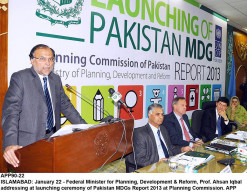
The government must take comprehensive steps to address unsustainable population growth if it wanted to provide better health facilities to its citizens, according to a new report.
The third Pakistan Demographic and Health Survey (PDHS) 2012-13 — launched by the National Institute of Population Studies (NIPS) here on Wednesday — said that excessive population growth was a serious challenge for Pakistan in ensuring access to quality health services.
According to the findings of the survey, the fertility rate in Pakistan has decreased from 4.1 births per women in 2007 to 3.8 in 2012, with the lowest rate recorded in Islamabad — three. The findings say that the teenage fertility has decreased from 16 per cent in 1990-91 to the current eight per cent.
NIPS Executive Director Abdul Basit Khan told The Express Tribune that the key findings of the survey reveal that Pakistan has made some strides in the health sector, but still lags far behind other South Asian countries.
He said that there was a dire need to focus on population welfare programmes to address issues at grassroots level and to achieve the Millennium Development Goals (MDGs).
NIPS Researcher Ali Anwar said that after the devolution of the ministry of health under the 18th Amendment, population welfare programmes have suffered setbacks. “There is a need to have a national plan on population at federal and provincial levels to improve the contraceptive prevalence rate (CPR),” he said.
Dr Nabila Ali from John Snow Incorporated (JSI) Research and Training Institute said that according to the survey’s findings, almost one child in every family was unplanned and there was dire need to focus on this issue.
According to the survey findings, the use of modern family planning methods has increased from nine per cent in 1990-91 to 26 per cent in 2012-13. According to the survey, though mortality rates differed from region to region, one in every 14 children died before the age of one.
The neonatal mortality rates have increased from 51 deaths per 1,000 live births in 1990 to 55 in 2012, but the infant mortality has decreased from 91 deaths per 1,000 live births in 1990 to 74 in 2012.
The findings say that vaccines coverage has gradually increased in Pakistan from 35 per cent in 1990 to 54 per cent in 2012. Over the same period, the percentage of children aged 12 to 23 months who did not receive any of the six basic immunisation vaccines has decreased from 28 per cent to the current five per cent.
Published in The Express Tribune, January 23rd, 2014.
COMMENTS (1)
Comments are moderated and generally will be posted if they are on-topic and not abusive.
For more information, please see our Comments FAQ



































1713853507-0/MalalaHilary-(2)1713853507-0-270x192.webp)








How can we cap population growth. We are delighted when we hear our population is increasing. More Pakistanis the better for us?